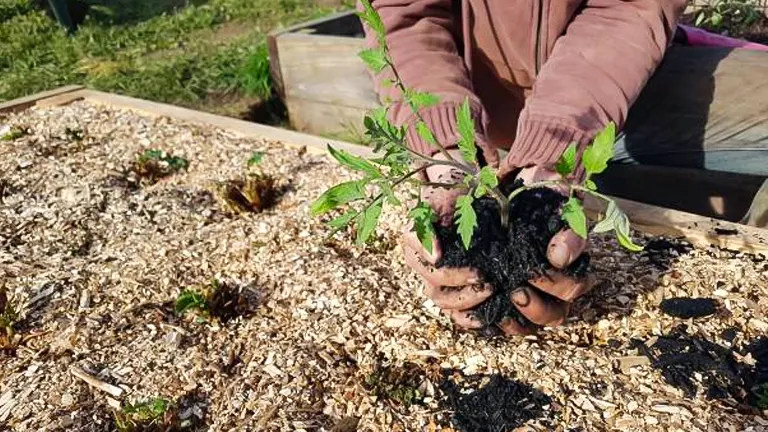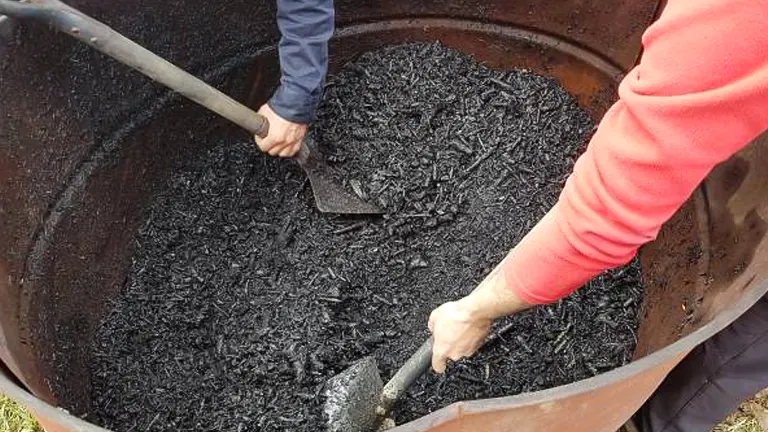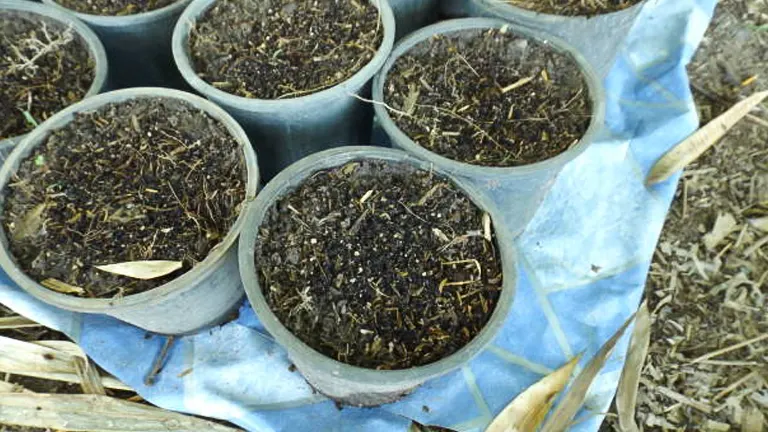The Science of Biochar: Enhancing Soil Fertility and Plant Growth
- June 13, 2024
- 1 comment
Explore The Science of Biochar and learn how it enhances soil fertility and promotes plant growth for healthier, more sustainable gardens. Dive into the fascinating world of biochar and discover how this simple substance can revolutionize your gardening experience.

Whether you’re a novice gardener or a seasoned green thumb, understanding the science behind biochar will unveil its potent capabilities in enhancing soil fertility and invigorating plant growth. Let’s uncover how biochar can be your garden’s best-kept secret for healthier plants and a more vibrant garden.
Table of Contents
- What is Biochar?
- The Science of Biochar
- Enhancing Soil Fertility with Biochar
- Biochar and Plant Growth
- Environmental Benefits of Biochar
- Practical Application of Biochar in Gardening and Agriculture
- Challenges and Considerations
- Future of Biochar in Sustainable Agriculture
- Conclusion
- FAQs
What is Biochar?

Biochar is a stable, carbon-rich form of charcoal produced through the pyrolysis of organic materials in a low-oxygen environment. This material is distinguished by its highly porous structure and large surface area which can reach up to 400 m²/g depending on the feedstock and pyrolysis conditions. Its production not only sequesters carbon effectively, preventing it from returning to the atmosphere as carbon dioxide, but also enhances soil fertility and structure.
Detailed Production Techniques
Biochar is created by pyrolyzing biomass, such as wood, leaves, manure, and agricultural residues, at temperatures typically ranging from 300°C to 700°C. The key variables in biochar production include:
- Temperature: Higher temperatures generally lead to a higher fixed carbon content and lower volatile matter.
- Heating Rate: Faster heating can increase the surface area and porosity of the biochar.
- Residence Time: Longer residence times at peak temperature can influence the total yield of biochar and its chemical properties.
The control over these parameters allows for the customization of biochar properties to suit specific agricultural and environmental applications.
Varieties of Biochar and Their Impacts
The source material and the specific conditions under which biochar is produced significantly affect its physical and chemical characteristics. These properties determine its effectiveness in different environmental applications, such as soil amendment, water filtration, and as a catalyst carrier. Key properties include:
- pH: Biochar typically has an alkaline pH, which can help in ameliorating acidic soils.
- Cation Exchange Capacity (CEC): High CEC enhances soil’s ability to retain nutrients.
- Porosity: Influences water retention and aeration in soils.
A scientific analysis of biochar’s efficacy in soil shows it can increase water retention by up to 18% and boost cation exchange capacity by 20–50 meq/100g, enhancing nutrient availability for plants.
Key Properties of Biochar Varieties Based on Feedstock
| Feedstock Type | Temperature Range (°C) | Estimated Surface Area (m²/g) | pH | Cation Exchange Capacity (meq/100g) |
|---|---|---|---|---|
| Wood Chips | 350 – 550 | 200 – 300 | 8.5 | 30 – 40 |
| Corn Stover | 400 – 600 | 250 – 350 | 9.0 | 35 – 45 |
| Rice Husks | 500 – 700 | 300 – 400 | 9.5 | 40 – 50 |
| Manure | 300 – 500 | 150 – 250 | 8.0 | 25 – 35 |
The Science of Biochar

Biochar is not just a soil amendment; it is a multifunctional agent that brings substantial changes to soil chemistry and biology due to its unique properties. At the microscopic level, biochar is predominantly carbon with a spongy texture that can dramatically enhance soil structure, nutrient retention, and microbial activity.
- Physical Structure: The porous nature of biochar increases soil aeration, crucial for root respiration and microbial activity. These pores also act as micro-reservoirs to store nutrients and water, thereby reducing the need for frequent watering and fertilization.
- Chemical Composition: Biochar is rich in functional groups such as carboxyl and phenolic hydroxyl, which can enhance its ability to bind and retain nutrients. This capability is critical in preventing the leaching of nitrogen, phosphorus, and other essential nutrients into groundwater.
- Biological Impact: Biochar has been shown to provide a habitat for beneficial soil microbes, which play a vital role in decomposing organic matter, cycling nutrients, and suppressing soil pathogens. Studies have shown that biochar can increase microbial biomass by up to 150% within a few weeks of application.
Soil Structure Enhancement
The integration of biochar into soil improves its physical and chemical properties in several key ways:
- Soil Aggregation: Biochar particles help bind soil particles together, improving soil structure and creating a more favorable environment for root growth.
- Bulk Density Reduction: Adding biochar can reduce soil’s bulk density, making it lighter and more porous. This enhances root penetration and water infiltration, crucial in compacted or clay-heavy soils.
- Water Holding Capacity: Biochar’s porous structure can increase soil’s water holding capacity by up to 25%, which is particularly beneficial during dry spells.
These properties make biochar particularly effective in rejuvenating degraded soils, enhancing plant growth, and improving crop yields in a sustainable manner.
Impact of Biochar on Soil Properties
| Soil Property | Effect of Biochar Addition | Measurement | Scientific Insight |
|---|---|---|---|
| Aeration | Enhanced | Up to 35% increase in porosity | Facilitates oxygen supply to root systems |
| Nutrient Retention | Increased | Reduces leaching by 20-40% | Improves nutrient use efficiency |
| Water Retention | Improved | Increases capacity by 10-25% | Mitigates water stress during dry periods |
| Microbial Activity | Stimulated | Biomass increase by up to 150% | Enhances organic matter decomposition |
| Bulk Density | Decreased | Reduction by 10-15% | Improves root penetration and growth |
Enhancing Soil Fertility with Biochar

Biochar’s application to soil is pivotal in enhancing nutrient retention, thereby boosting soil fertility and plant health. Its intricate porous structure is key in this process, providing a vast surface area that traps and holds nutrients which are critical for plant growth.
Long-Term Nutrient Reservoir
Unlike typical organic amendments that decompose, biochar’s robust structure allows it to persist in the soil for hundreds to thousands of years, acting as a long-term nutrient reservoir. This permanence is crucial for maintaining nutrient availability, especially nitrogen, phosphorus, and potassium, which are vital for plant health. By adsorbing these nutrients onto its surface, biochar reduces their leaching, especially in heavy rains, thus ensuring they remain in the soil and available for plant uptake.
Mechanisms of Nutrient Retention
Biochar adsorbs nutrients through ion exchange and adsorption processes, where nutrients bind to the negatively charged sites on biochar’s surface. This not only prevents them from washing away but also gradually releases them as plants require, enhancing nutrient use efficiency.
Regulating Soil pH with Biochar
Biochar’s impact on soil pH is another significant aspect of its benefit to soil fertility. Its alkaline nature makes it an effective liming agent, particularly beneficial in acidic soils.
Alkalinity and pH Adjustment
The inherent alkaline properties of biochar can raise the pH of acidic soils, which often lock up essential nutrients and inhibit plant growth. By adjusting the pH, biochar makes these nutrients more available to plants, thus enhancing the soil’s fertility and improving conditions for a diverse range of plant species.
Effects of Biochar on Soil Fertility and pH Regulation
| Biochar Feature | Impact on Soil | Quantitative Benefit | Explanation |
|---|---|---|---|
| Surface Area | High nutrient retention capacity | 300 m²/g to 400 m²/g surface area | Facilitates high levels of nutrient adsorption |
| Stability | Long-term nutrient availability | Up to 1000 years in soil | Reduces need for frequent reapplication |
| Nutrient Adsorption | Reduces nutrient leaching | Decrease leaching by up to 50% | Enhances nutrient availability for plant uptake |
| pH Modifying Properties | Adjusts and stabilizes soil pH | Can raise soil pH by 0.5 to 2 units | Improves nutrient solubility and availability |
Biochar and Plant Growth

Biochar’s contribution to plant growth extends beyond improving soil conditions—it has direct and significant impacts on plant health and vigor. Here’s a detailed analysis:
Habitat for Beneficial Microbes
Biochar’s porous structure creates an ideal environment for beneficial soil microbes, including bacteria and fungi that are essential for healthy plant growth. These microbes play a pivotal role in the nutrient cycle, breaking down organic materials into forms that plants can easily absorb. This microbial activity not only boosts nutrient availability but also enhances soil structure and plant resilience against diseases.
Enhancement of Root Systems
The addition of biochar to soil influences root development significantly. Its structure helps to reduce soil density, allowing roots to expand more freely and establish a robust network. This improved root biomass is crucial for enhanced nutrient and water uptake, directly translating into healthier and more vigorous plant growth.
Impact Across Various Plant Types
Biochar demonstrates benefits across a diverse range of plant species, making it a versatile amendment for any type of garden or agricultural practice:
- Vegetables: Incorporating biochar in vegetable gardens can lead to increased yields due to enhanced nutrient availability and improved soil moisture retention. This not only boosts growth but can also improve the taste and nutritional value of the produce.
- Flowering Plants: For ornamental plants, biochar-enriched soils can result in brighter, more vibrant blooms and increased longevity of the flowers, enhancing aesthetic value and bloom duration.
- Tree Crops: In orchards, biochar can improve tree health by enhancing root systems and increasing resistance to pests and diseases, leading to healthier fruit production.
Biochar’s Impact on Different Plant Types
| Plant Type | Improvement in Growth | Benefits Observed | Scientific Insight |
|---|---|---|---|
| Vegetables | Up to 20% yield increase | Enhanced nutrient uptake, improved taste | Increases in available potassium and nitrogen |
| Flowering Plants | Brighter and longer-lasting blooms | Greater floral display and vitality | Enhanced phosphorus availability |
| Tree Crops | Healthier root development | Increased fruit yield and quality | Improved water retention and nutrient efficiency |
Environmental Benefits of Biochar

Biochar offers a multifaceted approach to environmental sustainability, addressing critical issues such as carbon sequestration, greenhouse gas reduction, and waste management. Here’s an expanded analysis of each benefit:
Advanced Carbon Sequestration
Biochar’s role in carbon sequestration is pivotal in combating climate change. Through the process of pyrolysis, organic materials such as agricultural waste are transformed into biochar, effectively locking carbon into a stable, solid form that resists degradation. This carbon, otherwise released into the atmosphere as CO2 through natural decomposition, is retained in the soil for centuries, significantly diminishing the carbon footprint of agricultural activities.
- Scientific Insight: Biochar can retain about 50% of the carbon present in the original biomass, compared to only about 10% retained through natural decomposition processes.
Reduction in Greenhouse Gas Emissions
Biochar’s impact on reducing greenhouse gases extends beyond carbon dioxide. It notably reduces soil emissions of nitrous oxide (N2O), which is 298 times more potent as a greenhouse gas than CO2. Biochar modifies the soil environment, inhibiting processes that produce N2O.
- Quantitative Reduction: Research indicates that biochar can reduce N2O emissions from soil by up to 50%, depending on the type of biochar and soil conditions.
Sustainable Organic Waste Management
The production of biochar offers an innovative solution for managing biomass waste, which is often a by-product of agricultural processes. By converting this biomass into biochar, its potential environmental impact is not only neutralized but turned into a beneficial resource. This conversion process prevents methane production, a common byproduct of biomass decomposition and a significant greenhouse gas.
Quantitative Environmental Benefits of Biochar
| Benefit | Description | Quantitative Impact | Notes |
|---|---|---|---|
| Carbon Sequestration | Locks carbon in a stable, solid form | 50% of carbon in biomass retained as biochar | Significantly reduces long-term atmospheric CO2 levels |
| Reduction of N2O Emissions | Lowers nitrous oxide emissions from soils | Up to 50% reduction in N2O emissions | Addresses a potent greenhouse gas |
| Waste Management Efficiency | Converts biomass waste into a useful product | Prevents methane emissions from biomass decay | Enhances sustainability and resource recycling |
Practical Application of Biochar in Gardening and Agriculture

To harness the benefits of biochar fully, understanding the best practices for its application is essential. Here is a concise guide on how to incorporate biochar into your soil management strategy:
Guidelines for Integrating Biochar into Soil:
- Assessment of Soil Needs: Before adding biochar, assess your soil type and current condition. Biochar’s effects can vary depending on soil pH, nutrient levels, and existing organic matter.
- Biochar Application Rates: Generally, a one-time application of 10 to 20 tons of biochar per hectare is recommended for agricultural lands. For home gardens, about 1 to 2 kilograms per square meter should suffice.
- Mixing Biochar with Soil: Ensure biochar is thoroughly mixed into the soil, not just applied on the surface. This integration helps maximize contact between biochar and soil microbes, enhancing its effectiveness.
- Time of Application: Apply biochar to soil at least a few weeks before planting to allow it to integrate fully and start interacting with the soil ecosystem.
Long-term Management:
- Monitoring Soil Health: Regularly check soil pH and nutrient levels to gauge the impact of biochar and adjust your gardening practices accordingly.
- Reapplication Schedule: While biochar remains in the soil for years, additional applications may be beneficial every 4 to 5 years, depending on cropping intensity and environmental conditions.
Challenges and Considerations
Adoption Challenges
While biochar is praised for its environmental and agricultural benefits, its integration into mainstream practices faces significant barriers:
- Cost of Production: Establishing biochar facilities involves substantial capital investment. Advanced pyrolysis systems, which are essential for producing high-quality biochar that minimizes environmental risks and maximizes efficiency, can be prohibitively expensive. For instance, a typical pyrolysis unit capable of processing 10 tons of biomass daily may cost upwards of $400,000, posing a substantial barrier for small-scale farmers.
- Lack of Awareness: Despite its potential, biochar remains underutilized, partly due to a lack of widespread knowledge among agricultural professionals. Comprehensive educational programs and outreach are needed to bridge this gap, highlighting biochar’s role in enhancing soil fertility and sequestering carbon.
- Regulatory Hurdles: The regulatory landscape for biochar is often unclear, with many regions lacking specific guidelines or incentives for its use. This uncertainty can deter potential users from incorporating biochar into their soil management practices.
Economic Aspects
- Return on Investment (ROI): The initial costs of biochar are offset by its long-term benefits, such as decreased need for chemical fertilizers and improved crop yields. Research indicates that applying biochar can increase crop yields by up to 20%, significantly impacting ROI over several growing seasons.
- Scaling Production: As awareness and regulatory support improve, biochar production can be scaled up to meet growing demand. This scale-up has the potential to reduce production costs through economies of scale, thereby making it more accessible and affordable for widespread use.
- Long-term Effects: Ongoing research is crucial to unlocking the full potential of biochar. Studies focusing on its stability in soil show that biochar can remain effective for hundreds of years, affecting soil acidity and nutrient availability. Its impact on soil microbiota is also critical, as biochar can influence microbial communities that play a key role in nutrient cycling.
Scientific and Environmental Impact
- Carbon Sequestration: Biochar is a stable solid rich in carbon and can sequester carbon in soils for centuries, reducing the net greenhouse gas emissions of biomass by 12 to 84 times compared to if it were burned for energy.
- Soil Health: Biochar has been shown to significantly improve soil porosity and density, which enhances water retention and nutrient availability. The porous nature of biochar can increase soil water retention by up to 18%, crucial for crops in arid regions.
Biochar Impact Analysis
| Parameter | Impact | Measurement | Notes |
|---|---|---|---|
| Crop Yield Increase | +10-20% | Per season | Depending on crop and soil type |
| Carbon Sequestration | High | Up to 50 tons/ha | Over the lifecycle of the biochar |
| Water Retention | +18% | Soil capacity | Critical in water-scarce areas |
| Cost of Production | High | $400,000+ for setup | Initial investment barrier |
| ROI | Favorable | Assessed over multiple seasons | Long-term economic benefit |
Future of Biochar in Sustainable Agriculture
Looking ahead, the role of biochar in sustainable agriculture appears promising. Its potential for environmental improvement and agricultural productivity is significant, prompting increased interest from researchers, policymakers, and industry leaders. Here’s what to expect in the future:
- Innovative Research: Ongoing research aims to optimize biochar properties for specific soil types and climates, enhancing its effectiveness and applicability.
- Global Initiatives: International projects and collaborations are increasingly focusing on biochar to address climate change and food security, promoting its use worldwide.
- Technological Advances: New technologies in pyrolysis and biochar application are making the production process more efficient and environmentally friendly.
Related Post
- How to Build a Barn: A Step-by-Step Guide for Beginners
- How to Build a Sustainable Compost Bin: Easy and Eco-Friendly DIY
- How to Fertilize Bougainvillea: A Complete Guide for Stunning Blooms
- How to Fertilize Apple Trees: Essential Tips for a Bountiful Harvest
- How to Fertilize Lemon Trees: Secrets for Thriving Citrus
- How to Fertilize Avocado Tree: A Step-by-Step Guide for Lush Growth
- 10 Best Bow Saws to Buy in 2024: Top Picks for the Money
- Best Miter Saw For Beginners
- Top 10 Pruning Saws to Buy in 2024: Best for the Money
- 7 Best Pocket Chainsaw
Conclusion
Biochar stands out as a transformative solution in the realm of soil amendments, offering substantial benefits for soil health, plant growth, and environmental sustainability. By understanding and overcoming the challenges associated with its use, we can better harness its potential to secure a more sustainable future in agriculture. As we continue to explore and innovate, the science of biochar is poised to make significant contributions to our agricultural practices, enhancing productivity while caring for our planet.
FAQs
- What is biochar and how is it made?
Biochar is a carbon-rich product made from organic materials such as wood, manure, or leaves, burned at high temperatures in a low-oxygen environment, a process known as pyrolysis. The result is a stable form of carbon that can persist in soil for thousands of years. - How does biochar improve soil fertility?
Biochar enhances soil fertility by increasing soil porosity, improving moisture retention, and helping the soil hold onto nutrients longer. It also adjusts soil pH, making nutrients more available to plants. - Can biochar be used in all types of soil?
Yes, biochar can be beneficial in various soil types, but its effects can vary. For example, it’s particularly effective in sandy soils where nutrient retention is a problem, and in acidic soils where it can help raise the pH and improve nutrient availability. - Does biochar help with carbon sequestration?
Absolutely. Biochar is a stable form of carbon and does not decompose quickly. When added to the soil, it locks in carbon that would otherwise be released into the atmosphere, helping mitigate climate change by reducing greenhouse gas concentrations. - What are the environmental benefits of using biochar besides enhancing soil fertility?
Besides improving soil health, biochar reduces the need for chemical fertilizers, decreases agricultural runoff and soil erosion, and reduces the emissions of nitrous oxide, a potent greenhouse gas. - How often should biochar be applied to the soil?
Biochar is typically a one-time soil amendment because it remains active in the soil for years. However, additional applications may be beneficial every 4 to 5 years, depending on the crop cycles and soil conditions. - Are there any plants that particularly benefit from biochar?
While most plants will benefit from the improved soil conditions that biochar provides, it is especially beneficial for high-value agricultural crops such as vegetables, fruits, and flowers, which are particularly sensitive to soil conditions. - What should I look for when purchasing biochar?
Look for biochar that is specifically labeled for agricultural or horticultural use, as not all biochar is created equal. The best products will specify their source materials and the temperature at which they were produced, which impacts their properties and effectiveness.
For those interested in advancing sustainable agriculture, the science of biochar offers a promising path. By enhancing soil fertility and supporting plant growth, biochar stands as a key player in the future of eco-friendly farming practices.

Benjamin Brooks
Forestry AuthorGreetings! I'm Benjamin Brooks, and my journey over the past 15 years has revolved around the fascinating realms of content creation, expertise in snow clearing, and the intricate world of lumberjacking and landscaping. What began as a simple curiosity about the natural world and heavy machinery has evolved into a passionate profession where my love for crafting words intertwines seamlessly with my lumberjacking and garden skills.













Well written and primed to explain the concept of biochar production and application. Simple, easy and fun. Congrats.
Atu Initiative
August 11, 2024 5:43 am